
Croissants are made from laminated (layered) dough that results from the use of fat and the turning of the dough. That is done by encasing butter in the dough, and taking it through a series of rolls and folds, called turns, to produce layers of butter in between sheets of dough. These create fragile layers and an airy light texture.
The leavening in laminated doughs is derived mainly from the steam generated by the moisture in the butter during baking. The laminated fat acts as a barrier to trap the water vapor and carbon dioxide formed during baking. As the steam expands in the oven it lifts and separates the individual layers. While croissant and Danish dough do contain a small amount of yeast to aid in leavening, puff pastry relies solely on steam and requires a higher percentage of butter and a more elaborate folding process.
The key to success in the lamination process is maintaining the integrity of each layer. If the lamination is successful and the layers are maintained the baked croissants will be light and flaky. We show you how to achieve this.
PASTRY RECIPE HELP
INGREDIENTS
Croissant Dough (détrempe):
1 ounce fresh yeast or 2 1/4 teaspoons (1 packet) active dry yeast
3 1/2 cups unbleached all purpose flour; spoon into measuring cup and level to rim
1/3 cup sugar
2 teaspoons salt
1 1/4 cups whole or 2% milk
Butter Block:
4 1/2 sticks (1 pound 2 ounces) unsalted butter*, cold; cut into 1/2 inch pieces
2 tablespoons unbleached all purpose flour
Egg Wash:
1 large egg
1 tablespoon cold water
*NOTE ABOUT THE BUTTER: Use the best freshest – and richest – butter you can find. With it you'll notice a big difference in the flavor of your croissants.
1. For the recipe, cut the butter into 1/2-inch pieces.
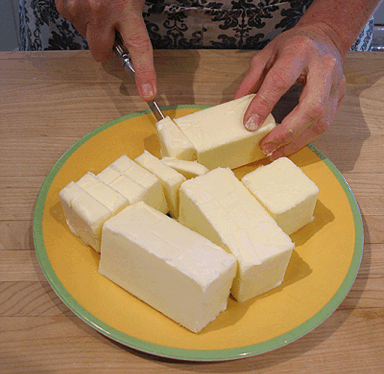
2. Chill until needed in the recipe,
INSTRUCTIONS
NOTE: All dimensions stated in the recipe are approximate.
STEP I: MAKE THE CROISSANT DOUGH (DETEMPRE) AND BUTTER BLOCK.
Make the Croissant dough:
1. Put the yeast, flour sugar, salt and milk into the bowl of a mixer fitted with a dough hook.

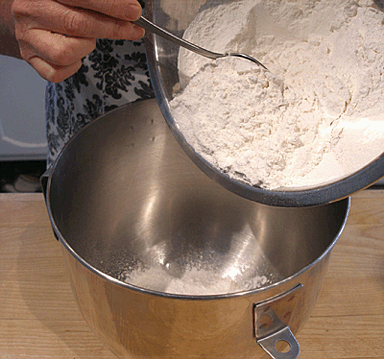
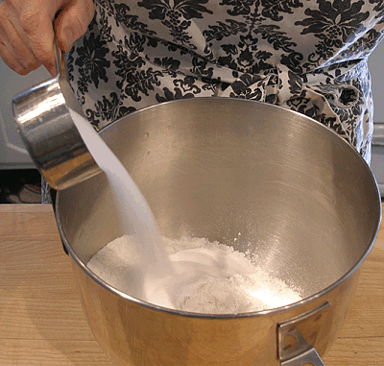
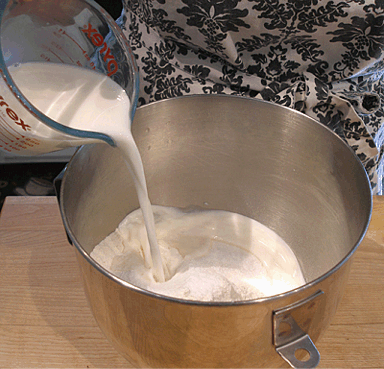
2. With the machine on its lowest speed, mix for 1 to 2 minutes, until a soft, moist dough forms on
the hook.
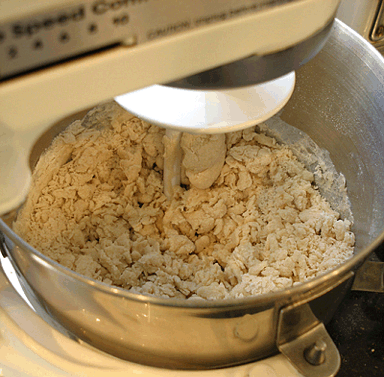
NOTE: If the dough is too dry, add more milk, a few teaspoon at a time, up to about 1 tablespoon or so. In most cases if the dough does need more liquid, but check carefully as you want all the flour to be moistened. Stop the mixer and look into the bowl. If the hook has not picked up all the flour from the bottom of the bowl, add a few more drops of milk.
3. Set the mixer to medium to medium-high speed and work the dough until it is smooth and elastic, no longer sticky and close to the consistency of soft butter, about 4 minutes.
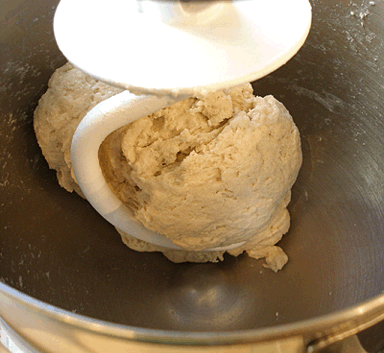
NOTE: To make certain that all the ingredients are perfectly blended you can remove the dough from the mixer after 3 minutes, and then with the mixer on medium speed, return plum size pieces to the bowl. The pieces will remain separate for a short while, then come together, at which time the dough is ready.
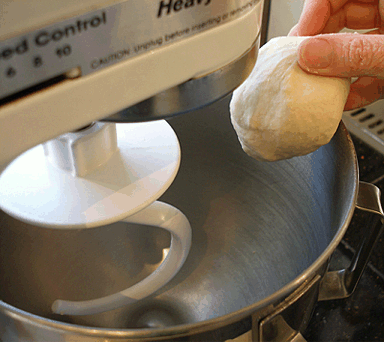
4. When mixed, remove the dough from the mixer, wrap it in plastic and put it in a plastic bag, leaving a little room for expansion. Keep the dough at the cool side of room temperature for 30 minutes to give the gluten time to relax; then refrigerate the dough for 8 hours or overnight.
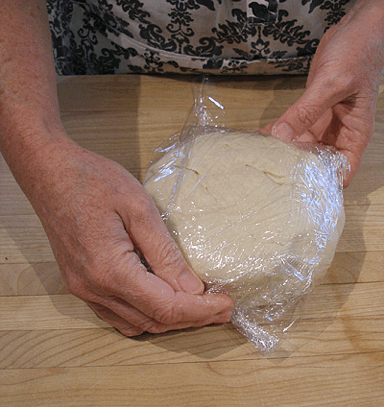
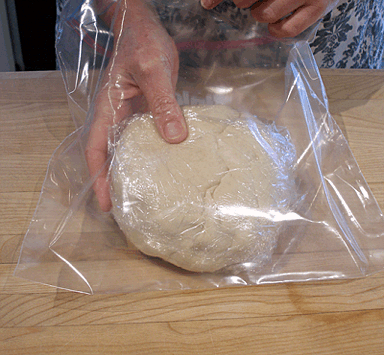
Make the Butter Block:
1. Attach the paddle to your mixer. Remove the butter from the refrigerator, and add it to the mixing bowl.
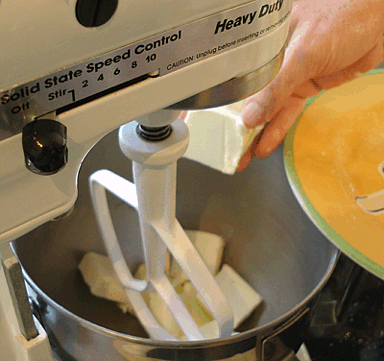
2. Start the mixer on low speed until the butter is just softened. You do not want to beat the butter and create air bubbles; you just want to slightly soften it.
3. Add the flour and mix on medium-low until incorporated.
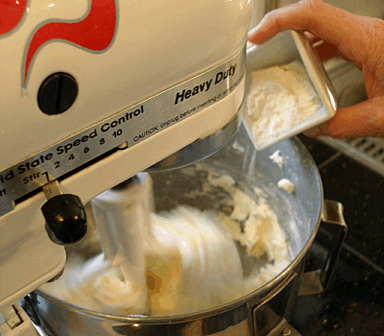
4. Then, mix the butter and flour mixture on medium-high speed until smooth, about 2 minutes.
NOTE: Reach into the bowl and poke around in the butter to make sure that its evenly blended – if you find any lumps, just squeeze them between your fingers. Turn the mixer on low to incorporate.
5. Scrape the butter onto a lightly floured work surface. Press on it a few times with a hand-held flexible bowl scraper to condense it.
The butter and flour mixture should be cold and malleable like clay.
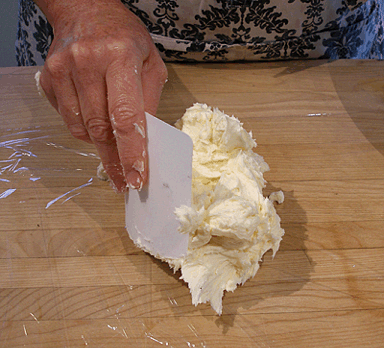
6. Mold it into an oval about 7-inches wide, 5-inches high and 1-inch thick. Wrap it tightly and refrigerate for about 1/2 hour.
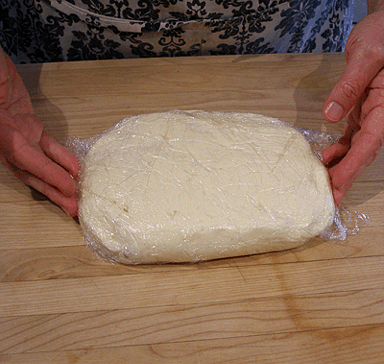
STORAGE
At this point the dough and the butter can be frozen; defrost both overnight in the refrigerator before proceeding with the recipe.
STEP II: ROLL THE CROISSANT DOUGH. INCORPORATE THE BUTTER BLOCK INTO IT
Make sure the croissant dough remains cool at all times.
Roll the croissant dough into an oval approximately 17-inches wide and 10-inches high.
1. Unwrap and place the croissant dough on a generously floured large work surface (marble is ideal because it remains cold).
Sprinkle the top of the dough with flour.
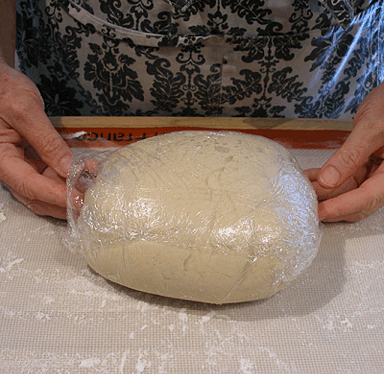
2. Using a long rolling pin, roll the dough into the right size.
3. With a pastry brush, brush the excess flour from the dough.
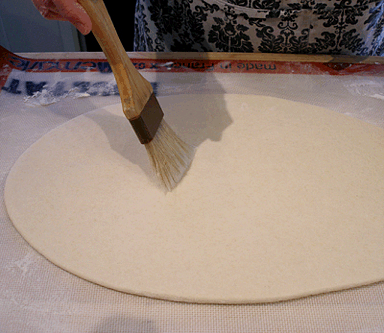
Incorporate the butter block into the rolled dough:
1. Make sure a 17-inch wide side of the dough still faces you.
2. Unwrap and center the chilled butter block across the oval of dough. Make sure the short end(5-inch side) of the butter block faces you.
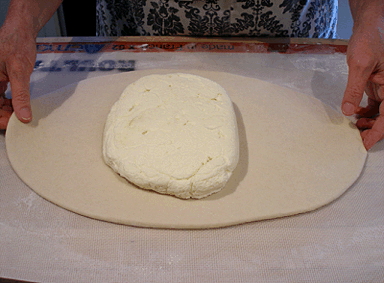
There should be about 6-inches of dough(the side flaps) on either side of the butter block, and about 1 1/2-inches of dough at the top and bottom.
2. Fold the side flaps of the dough over the butter block to make a tidy package.
a. First fold the left side of the dough(side flap) over the butter block. Make sure the edge of the dough reaches the right edge of the butter block.
Do not stretch the dough while doing so;
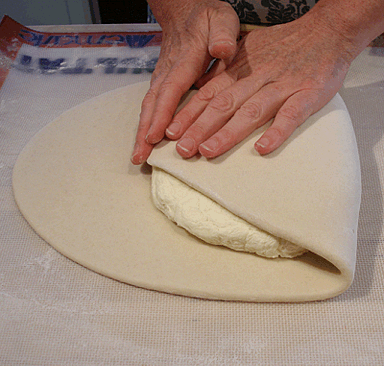
b. Fold the right side of the dough(side flap) over the butter block, and overlapping the first folded dough.
Make sure the edge of the dough reaches close to the left edge of the butter block. Do not stretch or force the dough;.
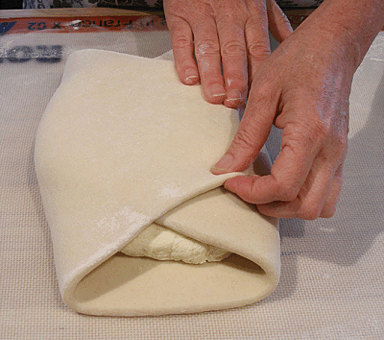
c. If necessary, with your hand, gently pull the bottom short side of the dough towards you, so it covers the butter block.
Then, press the edges of the dough nearest you down firmly with your fingertips to seal.
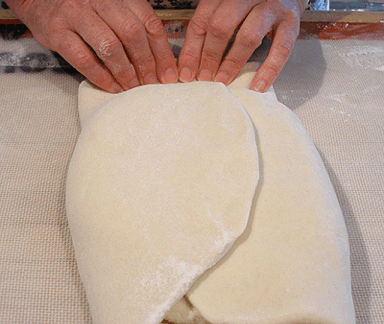
NOTE: The side flaps of the dough may no longer overlap over the top of the butter block, but will instead, overlap it slightly.
d. Turn the dough around so the other short side of the dough faces you. Repeat Step c, above.
This will create a neatly sealed rectangle; you should not see any parts of the butter block.

3. Wrap the dough in plastic and chill for about an hour.
STEP III: LAMINATE THE DOUGH THROUGH A SERIES OF ROLLS AND FOLDS CALLED TURNS
SARAH SAYS: There are several factors which affect the success of the lamination:
1. The dough must have a well-developed gluten structure to be able to support the expansion in the oven – that means to roll the dough, with the enclosed butter, with the rolling pin moving in a forwards motion, rather than back and forth; and,
2. The fat and dough must be rolled evenly in continuous layers. The accomplish this, the butter and dough should be at approximately the same cool(not cold and stiff) temperature, so the resulting layers of each can remain distinct from each other or the product will resemble brioche more than delicately layered and flaky laminated dough. The butter must remain in a “plastic” state when laminating; that is able to be molded and rolled without melting.
If the butter is too cold, it will break into pieces and/or break through the surface of the dough when it is rolled out. If the butter is too warm, it won't squeeze out of the edges of the dough layers or allow moisture to seep into the dough. If the butter is overchilled, leave it at room temperature and keep the dough in the refrigerator or vice versa, until both are the same temperature.
Pound the dough into a 1-inch thick rectangle about 14-inches long , 6-inches wide and 1-inch thick:
1. Unwrap the chilled dough and place on a floured work surface. The wide side of the dough should face you with the seam side up.
2. Flour the top of the dough.
3. Strike the dough all over until you have the right size. If at any time you see butter oozing from the sides, pinch the sides together and refrigerate the dough until cold.
To do:
a. Hold one side of the dough steady with your hand and strike the other side gently but firmly with the whole side of the rolling pin to distribute the butter evenly.
Hit the dough straight down with the side of the rolling pin; make sure you do not hit the dough at an angle because you do not want to see any dents forming in the dough.
As you hit the dough you will see the butter moving out into the crevices.
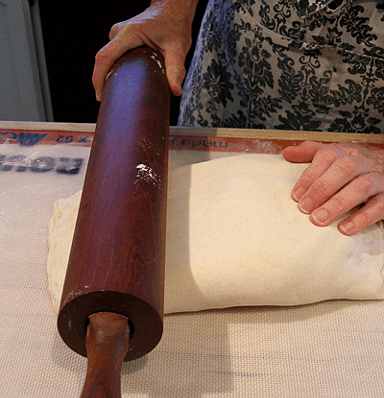
b. Strike the middle and the other side of the dough the same way.
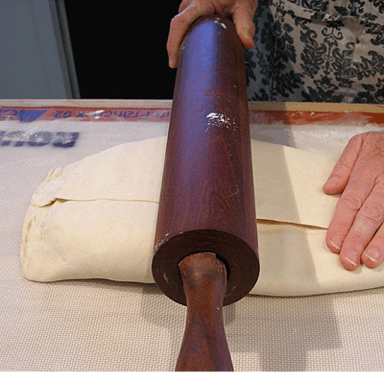
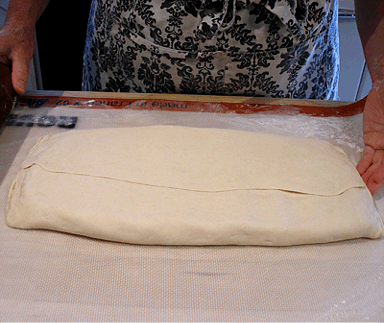
3. Brush any flour from the top of the dough. Wrap in plastic and refrigerate for 1/2 hour.
Roll and fold the dough, called turns:
You will accomplish three turns, with a refrigerator rest in between each one.
SARAH SAYS: The dough will be rolled and then, folded called “turns.” The dough must rest between turns, wrapped in the refrigerator, allowing the gluten structure to relax, making the dough more extensible and less likely to tear when rolled, again. If the dough is forced to stretch when rolled or the gluten structure of the dough tears, it will cause the dough to become tough and the baked croissants won't have the desired volume or texture.
NOTE: If this your first time working with croissant dough, you may want to roll out the dough just a little to distribute the butter, put it on a baking sheet lined with flour-dusted parchment paper, cover it with plastic and chill it for 1 to 2 hours first; this way you won't risk having the dough go soft or the butter seep out. If you're experienced, feeling courageous or have dough that is still well chilled, go on to make your first turn.
TURN #1:
1. Roll the dough into a rectangle 24-inches wide and about 13 to 14-inches high. (You may feel as though your rolling the dough sideways – you are.)
To do:
a. Flour the work surface. Position the unwrapped dough so a wide side faces you.
b. Flour the top of the dough, and roll it out until you achieve the right size.
c. On the surface of the rolled out dough, brush off the excess flour with a pastry brush.
2. Make sure the wide side of the dough still faces you.
Working from left to right, fold the dough inward into thirds, as you would a letter, called a “Letter Fold.”
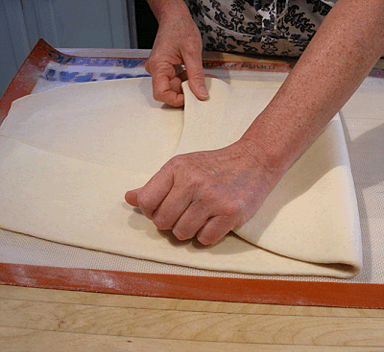
The final package should be about 8-inches wide by 14-inches high.
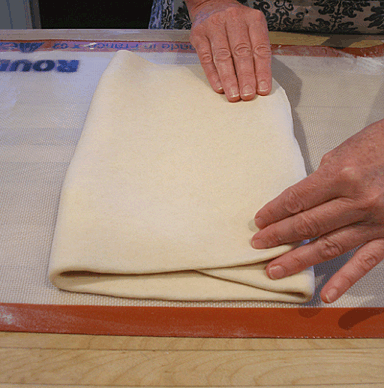
3. Carefully transfer the dough to a parchment paper-lined baking sheet. Brush off any excess flour on its surface with a pastry brush.
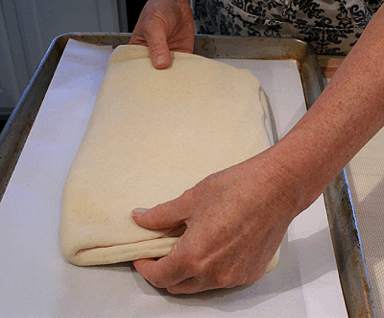
4. Mark the parchment “1 turn” so you'll know what you've done. Cover and refrigerate for at least 2 hours.
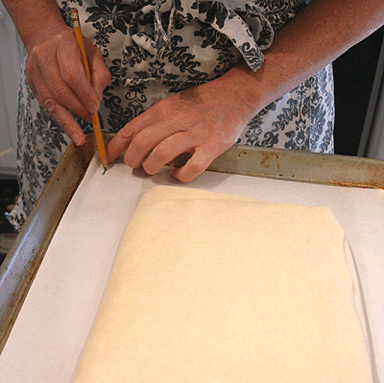
STORAGE
You can freeze the dough after this or any other turn. Thaw overnight in the refrigerator before proceeding.
TURN #2:
The dough needs 2 more turns; you've given it one already. When doing the second and third turns, you may find that the dough has cracked a little. That’s natural; it’s a result of the yeast. Don't worry, just flour the dough and work surface and keep going.
1. Roll the dough until it is rectangular in shape and measures 24-inches wide by about 13 – 14-inches high.
To do:
a. Flour your work surface, Place the unwrapped dough so that a 14-inch wide side faces you.
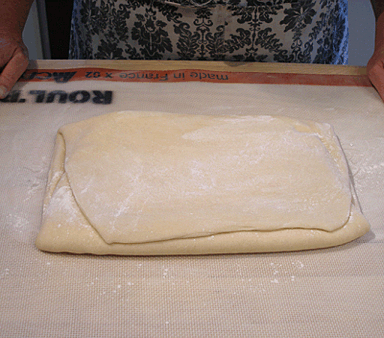
b. Sprinkle flour on top of the dough. And, roll the dough to the right size.
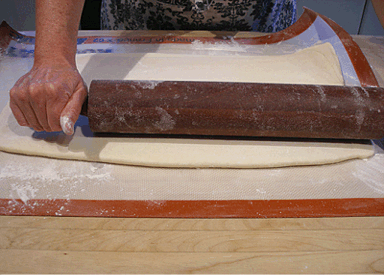
c. On the surface of the rolled out dough, brush off the excess flour with a pastry brush.
2. As you did before, fold the dough inward into thirds, as you would a letter, called a “Letter Fold.”
The final package should be about 8-inches wide by 14-inches high.
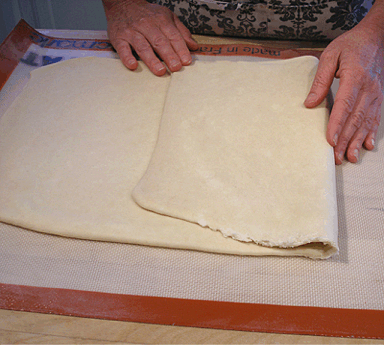

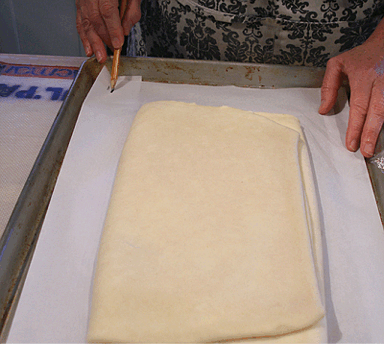
6. Place the croissant dough back onto on the parchment paper-lined baking sheet, mark the paper “2 turns”.
7. Brush off any excess flour on its surface with a pastry brush. Cover and refrigerate for at least 2 hours.
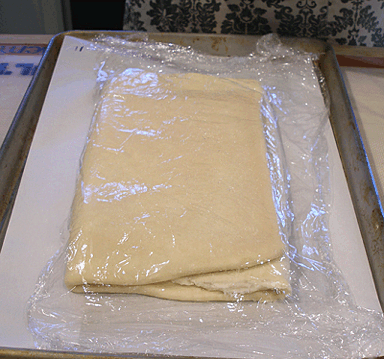
TURN #3:
1. Roll the dough into a rectangle, as you did in Turn #2, to 24-inches wide by 14-inches high.
To do:
a. Flour your work surface, Place the unwrapped dough so that a 14-inch side faces you.
b. Flour the top of the dough, and roll to the desired size.
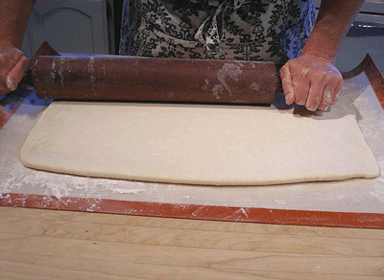
c. Brush off the excess flour on its surface.
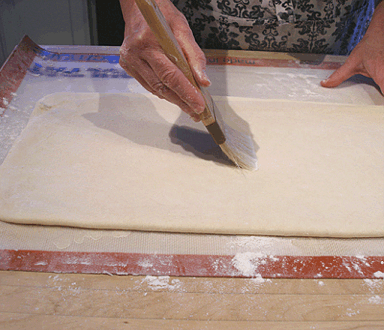
2. Fold the left and right sides of the dough into the center, leaving a little space in the center, called a “Book Fold”.
The dough will be 12-inches wide by 14-inches high.
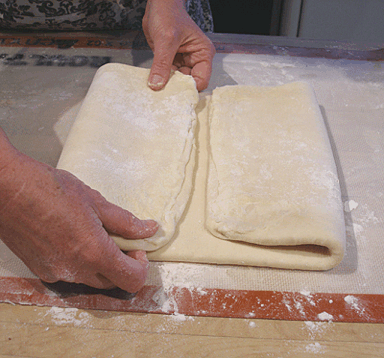
5. Brush the flour off the surface of the dough.
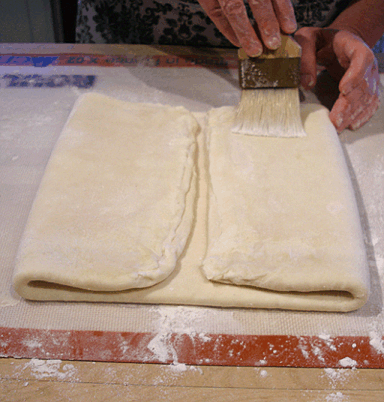
6. Then fold the left side over the other as though you were closing a book. This is the famous double turn, also known as “The Wallet”.
The dough will be 6-inches wide by 14-inches high.
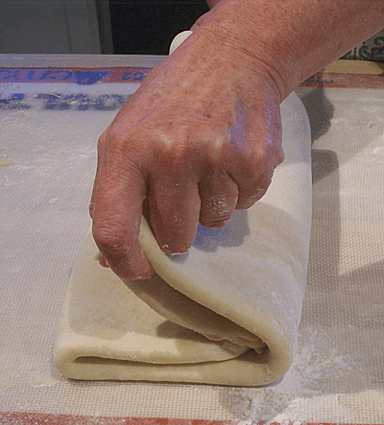
7. Brush off the flour, wrap the dough in plastic and refrigerate for 2 hours.
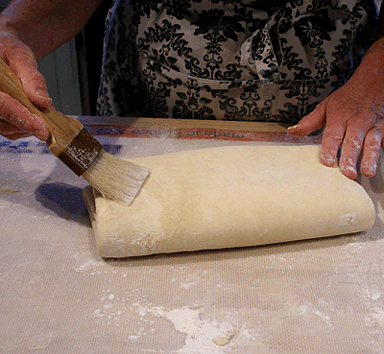
STORAGE
The dough can be frozen for up to 1 month. Thaw overnight, still wrapped, in the refrigerator.
STEP IV: SPLIT THE DOUGH IN HALF. ROLL OUT ONE CHILLED DOUGH HALF. CUT OUT THE CROISSANT TRIANGLES.
REPEAT WITH THE SECOND DOUGH HALF.
At this point the dough is ready to be rolled, cut and shaped into croissants.
Split the dough in half:
1. Generously flour the work surface. Unwrap the chilled dough.
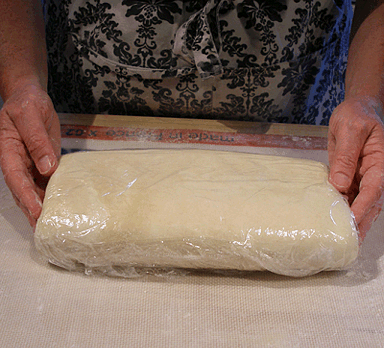
2. Place the dough so a short side faces you.
For easy handling, cut the dough in half horizontally so that you have two pieces, each about 6-inches wide and 7-inches high.
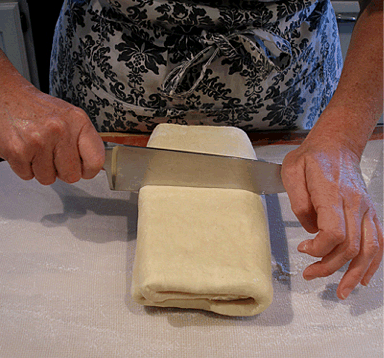
3. Wrap and chill one half while you work with the other half.
STORAGE
The dough can be chilled for about 1 to 2 days. You can optionally freeze all or half of the dough for about 1 month or more.
Thaw in the refrigerator in its wrappers when ready to use.
Roll the dough half into a rectangle that’s 21- to 22-inches wide and 13- to 15-inches high
To do:
1. Line a baking sheet with parchment paper. Set aside,
2. Position the dough on a floured surface so that it resembles a book, with the spine (large fold) to your left and the opening to your right.
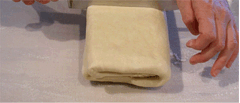
2, Flour the dough and roll it into the desired size.
This takes a lot of rolling. Keep the work surface and the dough well floured and have patience.
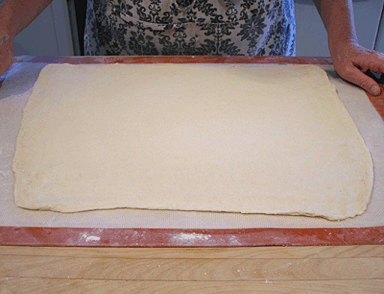
3. Brush the flour from the surface of the dough.
4. Carefully fold the dough in half; fold the top half of the dough down to the bottom.
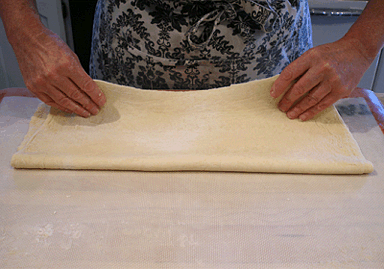
5. Brush the flour from the surface of the dough. If the dough is warm, wrap and refrigerate it for 1/2 hour or until chiiled.
Cut the dough into 5 or 6 triangles(you may even get 7):
Working with a pizza cutter or a large, very sharp knife (not serrated), cut triangles from the dough. You do not want to tear at the dough while cutting or cause it to be misshapen. If this happens, the dough is too warm. Wrap and refrigerate until chilled, again. The dough is now ready for cutting.
1. Line a baking sheet with parchment paper. Set aside.
2. Cut the dough by making a diagonal cut on the left hand side to get the pattern started. Do not knead the uneven piece together; just leave it flat. Wrap and place in the refrigerator.
(See in photo, below, right hand side.)
NOTE: You'll have another diagonal scrap when you reach the other end. You'll use these scraps when you shape the croissants.
2. Measure off a 3 to 4-inch base for each triangle.
To do: Measure each triangle base, starting from the left hand side of the dough nearest you. Make sure you mark the dough. On the top side of the dough (away from you), measure off each croissant triangle base by making small marks in the dough.
4. Begin cutting the triangles, rolling the pizza cutter from the bottom of the dough facing you, to the top.
If using a sharp knife, cut straight down through the dough; do not use a sawing motion.
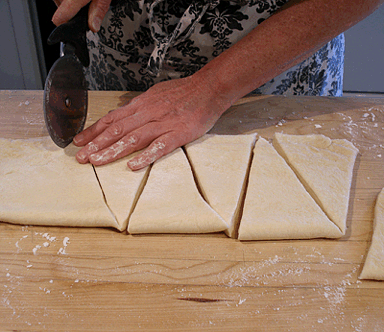
5. Unfold each pair of triangle. (Remember, you folded the dough in half before cutting it.)
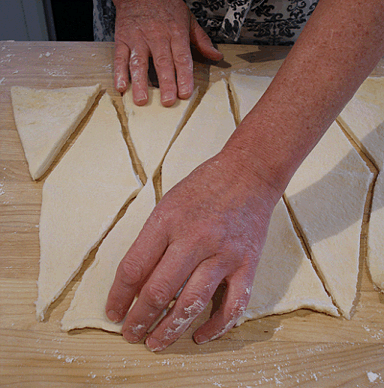
6. Cut them in half to separate. You should have 10 to 12 triangles(you may even have 14 triangles).
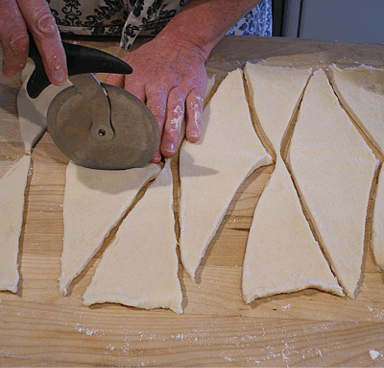
7. Place each triangle on the baking sheet. Cover and refrigerate while you perform the same steps with the second half of the dough.
STEP V: SHAPE THE CROISSANTS
A well shaped croissant takes practice to achieve one, and will show at least six clearly accountable sections, or ridges, from rolling.
1. Line two baking sheets with parchment paper. Make sure your work surface is free from flour.
2. Take one baking sheet of triangles at a time from the refrigerator. Moisten your hands with a wet towel.
3. Working with one triangle at a time, gently stretch the base to widen it slightly.
4. Then, holding the base of the triangle in one hand, run the fingers of the other hand down to the point of the triangle.
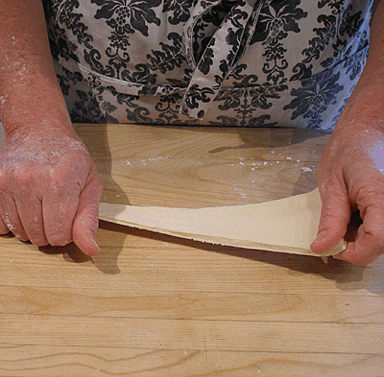
Use your thumb to pull and stretch the dough as best you can – have courage and tug; the extra length is what allows you to make a large croissant with sufficient rolls to show off it’s layers of dough. If you stretch the dough triangles too much, they tend to get wet and “icky.”
5. Place the triangle, point toward you, at arm distance on the work table. This will give you enough space to roll the croissant into shape with-out having to lift it in mid-roll).
6. Pull off a little piece of the reserved scrap dough, mold it into a small football shape without kneading the dough, and center it on the wide top part of the triangle. This will help make the “belly” of the croissant plump.
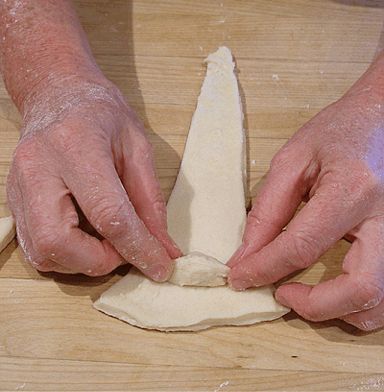
7. Fold about 1/2 inch of this wide end over itself and press the ends down once to secure.
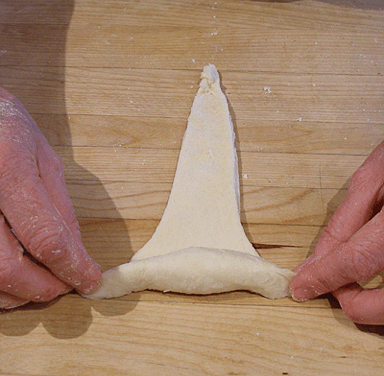
8. With you palms and fingers positioned over the flattened ends of the croissant and the heels of your hands on the flat work surface, roll the croissant toward you.
The dough should overlap at least 3 times.
Roll while pressing down on the work surface to create tension; you do not want loosely rolled croissant dough.
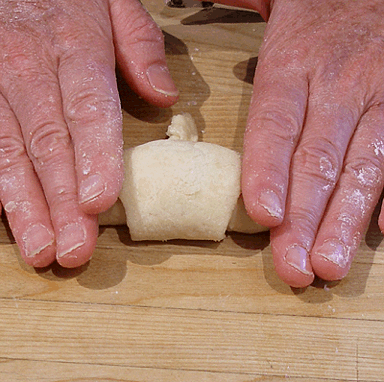
Try to keep your hands moving down and out to the sides as you roll – ending with the point of the triangle tucked under the croissant.
9. Give them a gentle plumping, carefully turning the ends down and toward the center to produce the classic croissant shape.
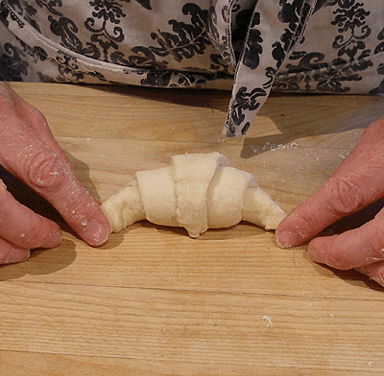
9. Place the shaped croissant on the reserved baking sheet. Make sure you leave room in between each one to be able triple in size without touching one another.
10. Loosely cover with plastic wrap while you work on the rest. If the room is warm, keep the shaped croissants covered and refrigerated; you do not want their butter layers to soften or melt.
STEP VI: GLAZE THE SHAPED CROISSANTS WITH EGG WASH. LET RISE. BAKE.
Glaze the shaped croissants with Egg Wash:
1. Beat the egg with cold water to make the Egg Wash. Brush each shaped croissant with it.
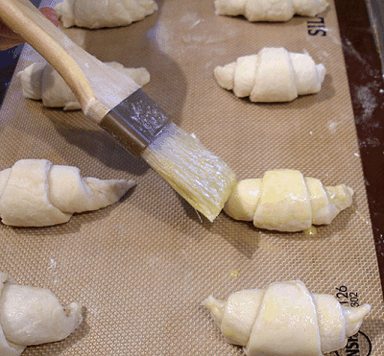
2. Reserve any unused egg wash, covered, in the refrigerator.
Let the croissants rise:
1. Allow them to rise, uncovered, at room temperature for 1 to 2 hours, until tripled in size and spongy.
Make sure the rising area is not too hot; you do not want the layers of butter to soften or melt. The ideal place for rising is a turned off oven(one with a pilot light is fine) containing a pan of hot steamy water.
NOTE: To test that they are properly risen, wet your fingers and squeeze the end of a croissant: It should offer no resistance and feel almost hollow.
Bake the croissants:
For best results, bake one pan of croissants at a time. This will allow for proper air circulation, resulting in light and airy croissants.
1. Position the oven shelf in the middle of the oven.
NOTE: If baking two pans of croissants at a time, arrange the oven racks to divide the oven into thirds.
2. Preheat the oven to 350 degrees F a good thirty minutes before baking.
NOTE: A well-preheated and hot oven is essential to their baking and puffing.
3. Gently brush the risen croissants once again with Egg Wash. Take care not to press down on the croissant dough while doing so.
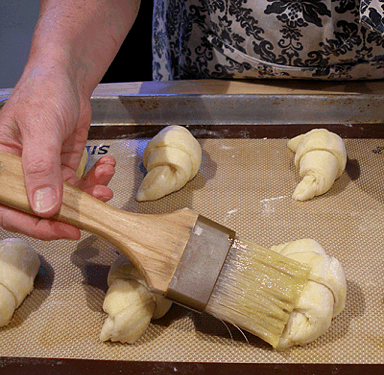
4. Bake the croissants for about 16 – 20 minutes. Do not open the oven door for the first 10 – 12 minutes.
Take them from the oven when the croissants are deeply bronzed.

5. Cool on wire cake racks.
NOTE: As tempting as they are croissants should not be eaten as soon as they come from the oven. The dough-and the layers-needs time to set.
STORAGE
Croissants are meant to be eaten the day they are baked; they do not store well at room temperature.
For best long-term storage, freeze baked croissants. Thaw in their wrappers.



